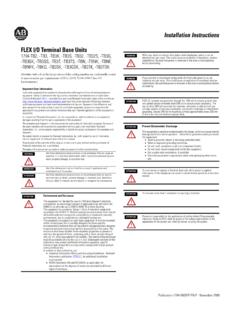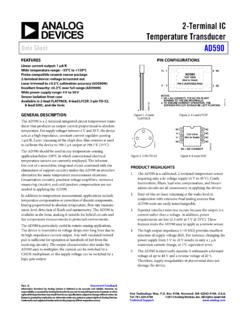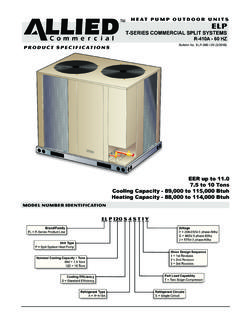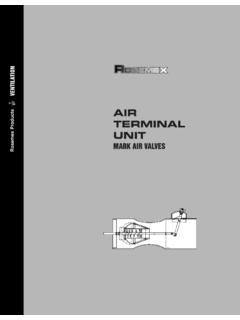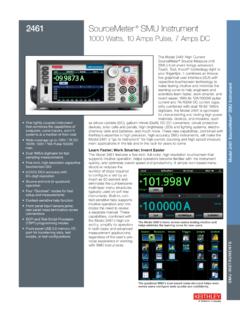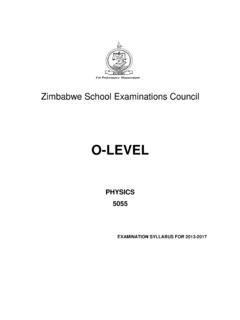Transcription of Lightning arresters’ effect on power line reliability
1 InfraMation 2003 ITC 035 A 2003-08-01 Lightning arresters effect on power line reliability Richard Strmiska Sumter Electric Cooperative, Inc., Box 301, Sumterville, Florida 33585-0301 ABSTRACT The reliability of electric lines is crucial to providing good service to our customers. Inspection can help prevent power line interruptions by detecting bad Lightning arresters in substations and on distribution lines. Infrared scanning of electric utility systems can identify overheated Lightning arresters quickly and accurately. This paper details how the system reliability for Sumter Electric Cooperative has greatly improved due to the early identification of hot arresters before they cause outages to the system. Performing an infrared inspection gives us the data needed to make decisions as to when to change out the arresters.
2 To further understand why Lightning arresters fail, our process has been to return the used arresters to the testing lab for study to pinpoint the reasons for failure. We feel that it is important to discover the root cause of arrester heating, which can lead to catastrophic and costly failures. Key Words: infrared, reliability , Lightning arresters, root cause, thermography, overheated, hot arresters, surge arrester INTRODUCTION With the implementation of an infrared program on a proactive basis, we at Sumter Electric Cooperative, Inc. are able to scan transmission lines, transmission substations, distribution substations, and distribution power lines. Our substations are scanned on a bi-monthly schedule. Transmission lines and substation feeder distribution lines are inspected within a twenty-four month time period.
3 The anomalies presented in this paper are seen on our system during routine infrared inspections during which we typically find a great number of hot distribution-type Lightning arresters. A Lightning arrester is defined as a device that limits surge voltage on equipment by discharging or bypassing surge current; it prevents continuous flow of 60 Hz follow current to ground and is capable of repeating this function as specified. A surge arrester is a voltage-sensitive device that operates, in principle, as a nonlinear resistor. To normal system voltage, it has very high impedance, and to voltages and current produced by Lightning it has very low impedance. 1. 69 kV STATION CLASS MOV TYPE ARRESTERS 80. 6 F126. 7 F90100110120SP0 1* : 120 . 1 FSP02: FSP03: F Figure 1. Failure of a 69 kV Lightning arrester . This problem could have affected reliability of this power system by causing an outage to several thousands of consumers being served by this substation.
4 InfraMation 2003 ITC 035 A 2003-08-01 These types of Lightning arresters are used in substations to protect the station and equipment from incoming surges due to Lightning and almost any type of fault current. The data in the picture show the elevated temperature of the hot arrester in question. Failure of this type of arrester could affect a large number of consumers due to the size of these substations and where they are located. The picture below is an example of a hot 69 kV MOV arrester . 2. INTERMEDIATE STATION CLASS arrester This type of MOV arrester is used on the distribution side of a substation on three phase feeder lines at the substation. F90100110120130S P 01: 136. 0 FS P 02: 118. 6 FS P 03: 127. 5 FFigure 2. The heating problem with these arresters could have affected the reliability of this three phase feeder line .
5 Feeder lines such as these serve 2,550 consumers. 3. REGULATOR Lightning arrester This by-pass type arrester is used on regulators in substations. It is attached between the source and load bushings in series with the windings for Lightning protection. SP01: F F0204060SP02: F F020406080100SP01: FSP02: F Figure 3. This problem arrester on the voltage regulator upon failure could have affected the reliability of the regulator and/or the total substation. This substation serves a total of 2,120 consumers. 4. 18 kV Lightning arrester This 18 kV type Lightning arrester , along with the 9 kV Lightning arrester , has affected the reliability of our distribution system the most. The buildup of heat due to internal moisture or block failure enables the arrester to dump high amperage to ground if the isolator does not blow causing the substation breaker to relay the distribution line which now has affected reliability of power to the consumers InfraMation 2003 ITC 035 A 2003-08-01 5.
6 INVESTIGATING FAILED arrester UNITS Nine Catalog No. 8154C0018 18 kV type ZQP arresters were returned from the field without correspondence. A packing slip simply included the notation, Failed in field. Inspection Results All nine units had been manufactured during the first quarter of 1995. They are numbered 1 through 9 for discussion purposes only. The disconnect on unit 6 was broken, but showed no evidence of 60 Hz arcing on the metal parts. The disconnect on all other units were intact. The insulating brackets of units 1 and 8 were broken all others were intact. The polymer housing of units 2, 3, 5, 7, and 8 were slightly browned. The reference voltage and power dissipation of all units were measured (Table 1) and the units disassembled for inspection. The height of the upper and lower O ring stud seals above the top of their retaining grooves were measured (see Table 1) and the condition of the sealant on the upper and lower covers was noted (see Table 2).
7 The stack assembly of each unit had turned slightly yellow. Treatment All intact stacks were heated in an oven at 120 C for 36 hours to drive out potential absorbed moisture. The measurements before and after treatment are listed in Table 1. The conclusion was that water ingress decreases the resistance of the arresters, allowing more current to flow, causing heating, as illustrated in Fig. 4. Table 1: Unit Measurements. Highlighted values are beyond acceptable limits. Unit No. "O" ring Height (in.) V ref (kV, peak) power (watts) Top Bottom Before After Before After 1 .007 .005 2 .006 .008 3.
8 010 .003 4 .000 .002 5 .003 .003 6 .010 .004 7 .004 .005 8 .001 .004 9 .002.
9 005 Limits minimum maximum Figure 4. The thermograph shows a high amount of heat present within the arrester , thus causing the feeder to relay open. This also holds true for fused taps. The next page shows examples of the tests on returned Lightning arresters that showedup hot on the distribution F90100110120130S P01* : FSP02: FS P 03: 118. 7 FS P 04: 132. 6 FS P 05: 130. 1 FS P 06: 126. 8 F InfraMation 2003 ITC 035 A 2003-08-01 Table 2: Test results--condition of sealant on covers. All sealant was jet black in color. Unit No. Upper Lower 1 7/16" gap 3/8" gap 2 Totally inside housing Full coverage 3 Non-uniform Full coverage 4 Non-uniform Full coverage 5 Full coverage Full coverage, but very heavy 6 Non-uniform, possible 5/16" gap Full coverage 7 Non-uniform Full coverage 8 Full coverage Non-uniform, possible 1/8" gap 9 Non-uniform Possible 1/8" gap Conclusion The improvement in power dissipation measurements after heating indicates that moisture had been present in the blocks and stack assembly.
10 All but one power reading was still above acceptable minimums, but further heating would have eventually removed all moisture. Both gaps in the cover sealant and low sealing pressure of the O rings are possible reasons for moisture to have entered. Breakages of the two disconnects did not appear to have been caused by action of the powder charge. They may have occurred because of rough handling during removal or during return shipment. Corrective Action In August of 1996, sealant material was changed to a gray butyl material that has better adhesion to stainless covers, polymer housings and insulating brackets. It also has better aging and life characteristics. Also implemented in July of 1997 was a change in the O ring seal design. The retaining groove dimensions were changed to prevent over-compression of the O ring that might result in the gasket taking a compression set.
